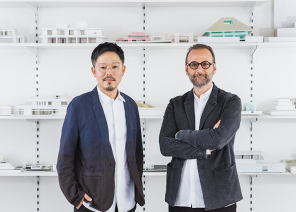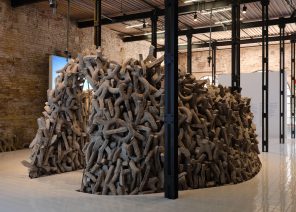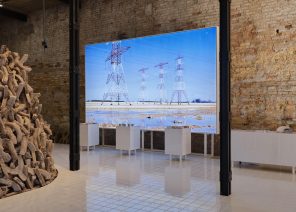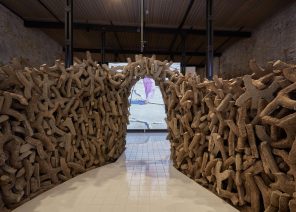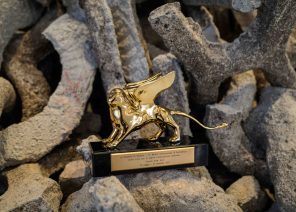2021
NPUAE Continues Research Into Sustainable Cement

27 January 2021, United Arab Emirates: For its tenth participation in the International Exhibitions of Art and Architecture organized by La Biennale di Venezia (Venice Biennale), the National Pavilion of the United Arab Emirates is conducting groundbreaking research into an environmentally-friendly cement alternative inspired by the UAE’s sabkha (salt flats) and created from salts and minerals extracted from waste brine left over from water desalination.
The production of traditional cement generates 8% of the world’s CO2 emissions, while brine, highlysaturated saltwater left over from industrial desalination, is often poured back into the oceans with significant impact on marine life and ecosystems. In keeping with the Biennale’s overall theme How Will We Live Together, the UAE’s curators Wael Al Awar and Kenichi Teramoto are researching a solution addressing both these harmful environmental issues: an MgO-based alternative cement created from recycled waste brine.
This strong, insoluble building material was inspired by the crystallized salts and minerals found in the UAE’s Sabkhas (salt flats), which have been tentatively listed as a UNESCO World Heritage Site, meaning that the exhibition explores the intersection of an ancient ecological treasure and innovative sustainability research. Visitors can currently visit the Wetland research lab at Alserkal Avenue to see samples of sabkhas, images and material experiments as the curators continue their research in partnership with specialist teams at the Amber Lab at NYU Abu Dhabi, the American University of Sharjah and the University of Tokyo.
The project will be supplemented by a book titled The Anatomy of Sabkhas, written by urban researchers Rashid and Ahmed bin Shabib, expected to be released in May. The book will explore the ecological and socio-economical significance of these natural phenomena in detail based on case studies, personal essays, and photography. A supplementary volume edited and written by Aga Khan Award-winning architect Marina Tabassum will detail the journey of Wael and Teramoto’s research for the Wetland exhibition.
Laila Binbrek, Coordinating Director, National Pavilion UAE – La Biennale di Venezia said: “The National Pavilion UAE provides a high-profile platform for curatorial and research concepts that address international conversations from a distinctive local perspective. Wetland and the accompanying research put the UAE at the heart of a vital global dialogue about the future of architecture and its impact on climate change and our natural resources.”
Wael Al Awar and Kenichi Teramoto said: “The structure of the UAE’s natural sabkhas offers ecological insight into the world’s most vital challenge: climate change. In researching ways to address the irreversible impact of industrial construction and desalination, we have aimed to bring vernacular architecture into the 21st century by creating a sustainable material that could recycle industrial waste and reduce the world’s reliance on Portland cement. Our work with the National Pavilion UAE has provided us with the resources to experiment with this vision through a collaborative process, enabling us to develop a proof of concept showing that locally-sourced salt-based cement is a viable, scalable alternative.”
Ahmed and Rashid bin Shabib said: “As renewable energy, climate change and sustainability become the most urgent cause of our generation, we must turn to the natural world for answers. One square meter of sabkha can sequester more carbon than one square meter of rainforest1 , yet our understanding of them is still in its early stages. Through this publication we demonstrate that the UAE’s sabkha are an essential part of our ecological order and are vital to plant growth, animal migration and biodiversity. We ask how we can preserve, study and nurture sabkha from both a rural perspective, looking at their geological networks, and an urban one, exploring humans’ rich historic relationships with the sabkha as a natural resource.”
In line with the National Pavilion UAE’s ongoing role as an important platform for dialogue and discussion, the pavilion has collaborated with Dubai Future Foundation to present a series of public talks titled “From Liwa to Mars, The Anatomy of Sabkhas”. The series will expand on themes related to Wetland and the sabkhas. Wael Al Awar and Kenichi Teramoto will also be speaking at The World Around Summit, a global architecture conference examining the most urgent topics related to the environment, equity and the city, on 30 January, 2021. To register, visit theworldaround.com.
The project is scheduled to be presented at the National Pavilion UAE at the 17th International Architecture Exhibition of the Venice Biennale from Saturday May 22nd to Sunday November 21st 2021. While preparing for the exhibition, the National Pavilion UAE continues to monitor the situation closely with the safety of staff and visitors as its top priority.
The theme of the Architecture Exhibition, ‘How Will We Live Together?’, calls for pavilions to look at architecture’s ability to engage people and communities across increasing social, economic, political and digital divides. The National Pavilion UAE’s exhibition has responded to this call not only through its curatorial concept but although through its collaborative approach to developing the project and publication, convening a diverse group of partners, researchers and universities to contribute.
